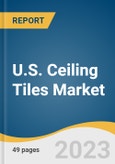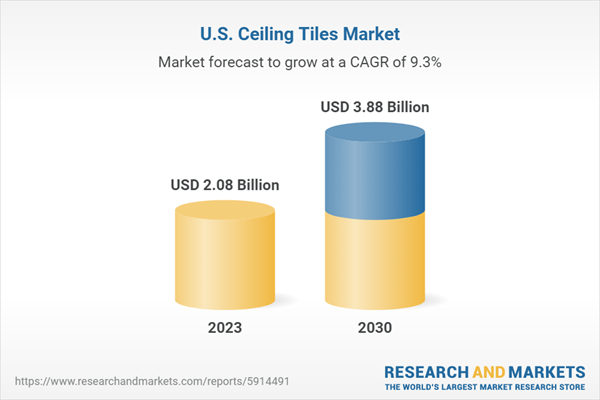Ceiling tiles offer a number of advantages, including aesthetic appeal as well as improving the insulation of homes, thereby, saving energy. Buildings are valued higher if they include ceiling tiles, which aids in increasing the overall value of the building while selling or renting out. In addition, the product is easily replaceable when compared to other types of ceiling products. The damaged ceiling tiles can be replaced individually; however, in the case of other ceiling types, full restoration may be required, which raises the overall cost to a customer.
The growing prevalence of acoustic and sound management technologies in ceiling tiles is driving the market growth. As businesses and individuals prioritize comfortable and noise-controlled environments, this product with embedded acoustic materials and advanced sound absorption features is gaining traction. These tiles not only enhance acoustics but also improve overall occupant satisfaction. In addition, with the rise of the Internet of Things (IoT), ceiling tiles are now being equipped with sensors and connectivity capabilities. This enables them to monitor and regulate aspects such as lighting, temperature, and air quality in real-time, enhancing energy efficiency and creating more adaptable and responsive environments.
The increasing consumer interest in translucent or light-transmitting ceiling tiles reflects a significant shift in architectural and interior design toward more sustainable, energy-efficient, and visually pleasing spaces. These innovative tiles are designed to allow natural light to filter through the ceiling, effectively reducing reliance on artificial lighting while simultaneously creating an open and inviting atmosphere.
The natural light entering through these tiles can have a profound impact on the overall ambiance of a space. It fosters a connection between indoor and outdoor environments, bringing the benefits of nature into the built environment. The result is a more pleasant and calming atmosphere that can enhance the well-being and productivity of occupants.
Companies operating in the market include Johns Manville; American Excelsior Company; USG Corporation; American Gypsum; Supreme Perlite. To prevent disruptions in raw material supply, manufacturers tend to keep strategic connections with raw material suppliers. Additionally, there is a high degree of backward integration, with manufacturers serving as major raw material producers, including Armstrong World Industries, Inc. This will help manufacturers to decrease the price of a product and gain a competitive advantage.
U.S. Ceiling Tiles Market Report Highlights
- Based on material, the mineral wool segment dominated the market with a revenue share of 42.9% in 2022. The use of mineral wool in ceiling tiles leads to the development of their aesthetic designs, enhances their fire resistance, and results in their effective thermal insulation. Moreover, mineral wool ceiling tiles are more economical than product types developed from other materials. This also contributes to the demand for the former in the U.S
- Based on application, the non-residential segment dominated the market with a revenue share of 79.3% in 2022. Growth of this segment can be attributed to increasing investments in the development of new commercial spaces and ongoing refurbishments of existing and old commercial structures such as office complexes, institutional buildings, hospitals, and retail outlets in the country
- Companies have been adopting various strategies such as new product developments, partnerships, joint ventures, agreements, contracts, and collaborations to maximize their market penetration in the U.S. Some major companies operating in the market are AWI Licensing LLC; USG Corporation; ROCKWOOL A/S; Hunter Douglas N.V.; CertainTeed; and others
Table of Contents
Companies Profiled
- AWI Licensing LLC
- USG Corporation
- Genesis Products
- ROCKWOOL A/S
- Odenwald Faserplattenwerk GmbH
- ArtUSA Industries, Inc.
- SAS International
- Hunter Douglas N.V
- American Tin Ceilings
- CertainTeed
- Acoustical Surfaces, Inc.
- BAUX AB
Table Information
| Report Attribute | Details |
|---|---|
| No. of Pages | 49 |
| Published | November 2023 |
| Forecast Period | 2023 - 2030 |
| Estimated Market Value ( USD | $ 2.08 Billion |
| Forecasted Market Value ( USD | $ 3.88 Billion |
| Compound Annual Growth Rate | 9.3% |
| Regions Covered | United States |
| No. of Companies Mentioned | 12 |









